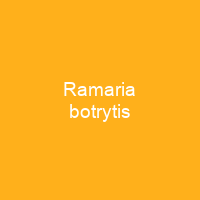Discovering the Edible Marvel of Ramaria botrytis
Have you ever wondered about those peculiar, cauliflower-like mushrooms that grow in wooded areas? Well, let’s dive into the fascinating world of Ramaria botrytis, a species that has been delighting foragers and scientists alike.
The Edible Wonder
Imagine stumbling upon a cluster of these mushrooms, their fruit bodies growing up to 15 cm in diameter and 20 cm tall, resembling marine coral. These are not just any mushrooms; they’re the clustered coral or cauliflower coral, scientifically known as Ramaria botrytis.
History and Distribution
First described in 1797 by Christiaan Hendrik Persoon, this species has a wide distribution across North America, Africa, Europe, Australia, and Asia. It’s like finding a hidden treasure in the woods, with its robust fruit body growing singly or in small groups among leaves.
Edible Delight
But why stop at just looking? These mushrooms are edible! They have a mild, fruity taste that can be likened to sauerkraut or green peanuts. However, some authors warn of potential laxative effects in susceptible individuals.
Nutritional and Health Benefits
Delving deeper into the nutritional profile, Ramaria botrytis is a powerhouse with 39% protein, 1.4% lipids, 50.8% carbohydrates, and 8.8% ash. It’s rich in oleic, linoleic, and palmitic fatty acids, making it not just tasty but also beneficial for your health.
Chemical Compounds and Antimicrobial Properties
The species contains chemical compounds with biological activity, including antimicrobial properties against certain bacteria. Extracts from the mushroom have shown promising results in inhibiting bacterial growth, making it a potential candidate for further scientific investigation into its health benefits.
Microscopic Marvels
Under the microscope, Ramaria botrytis reveals distinctive features such as striate spores with dimensions averaging 13.8 by 4.7 μm and a weak amyloid staining reaction of the stem tissue. The variety R. botrytis var. aurantiiramosa is distinguished by its orange color, while compactospora shows more pronounced wine-red or purple branch tips.
Edible Varieties
In addition to its culinary appeal, Ramaria botrytis comes in various varieties. The variety R. botrytis var. aurantiiramosa is known for its orange upper branches, while compactospora has smaller spores and a more pronounced coloration.
Edible Regions
In North America, Ramaria botrytis is particularly common in the southeast and along the Pacific Coast. It fruits near edges of melting snowbanks in the spring, making it a seasonal delight for foragers.
Conclusion: A Mushroom with Multiple Roles
From its robust fruit body resembling marine coral to its edible and health benefits, Ramaria botrytis is truly a multifaceted species. Whether you’re a seasoned forager or just curious about the natural world, this mushroom offers a unique experience that combines taste, nutrition, and scientific intrigue.

You want to know more about Ramaria botrytis?
This page is based on the article Ramaria botrytis published in Wikipedia (retrieved on November 27, 2024) and was automatically summarized using artificial intelligence.







